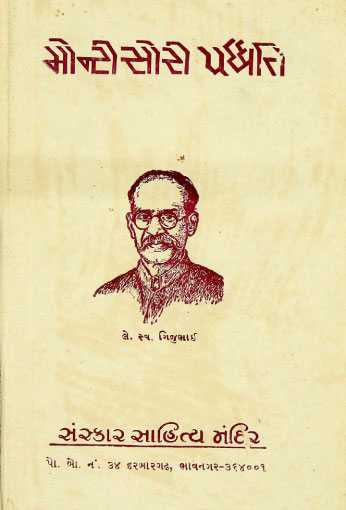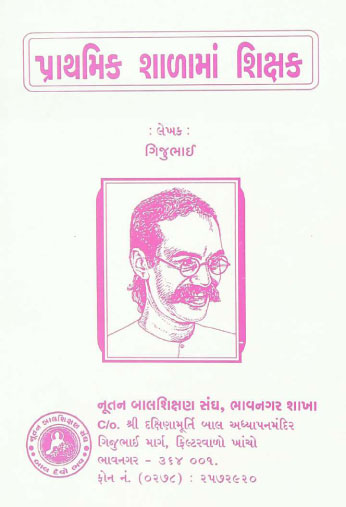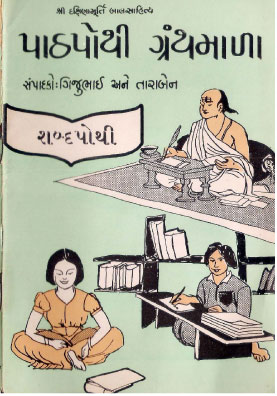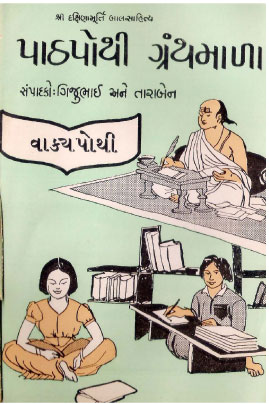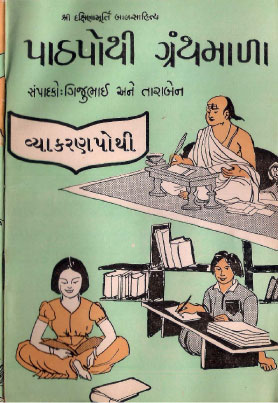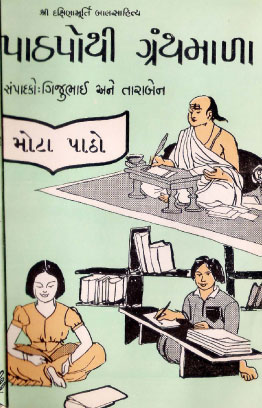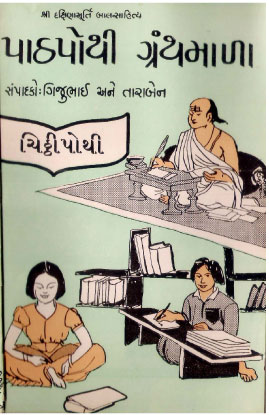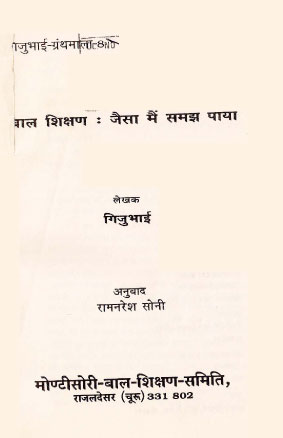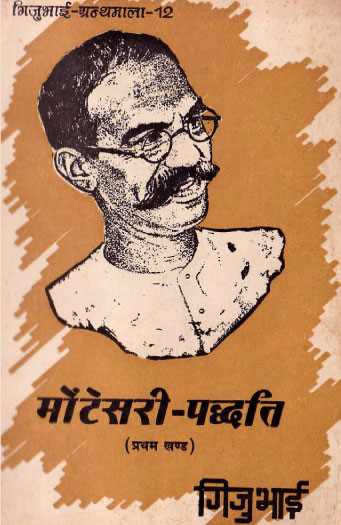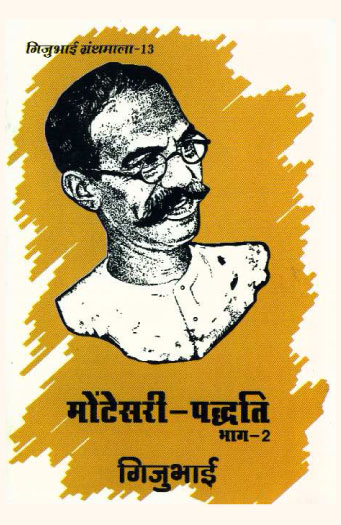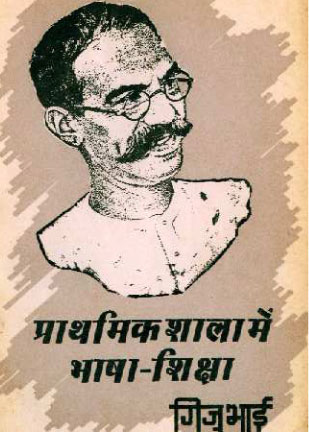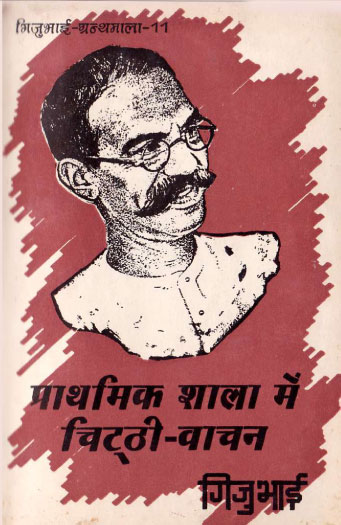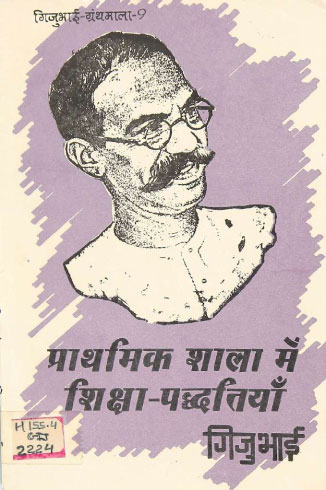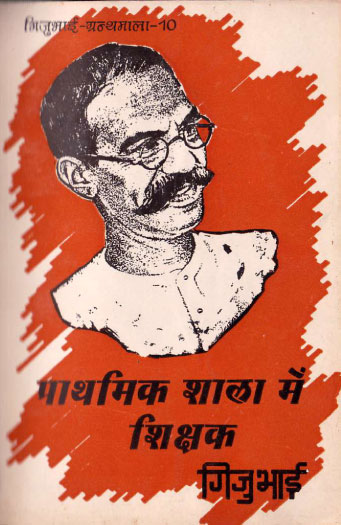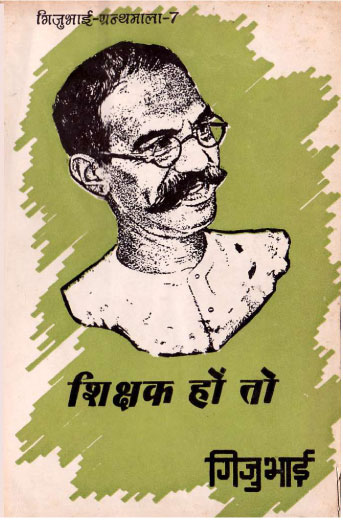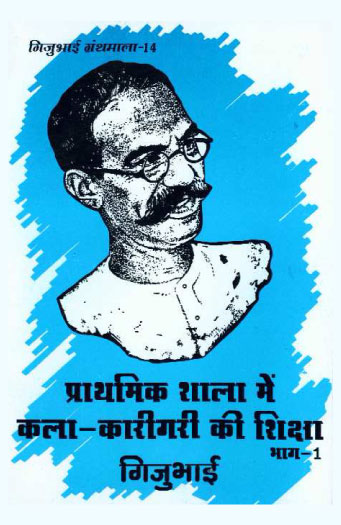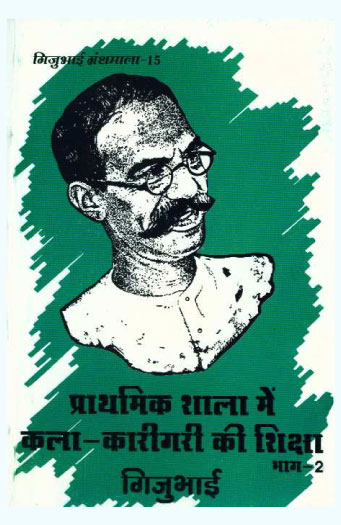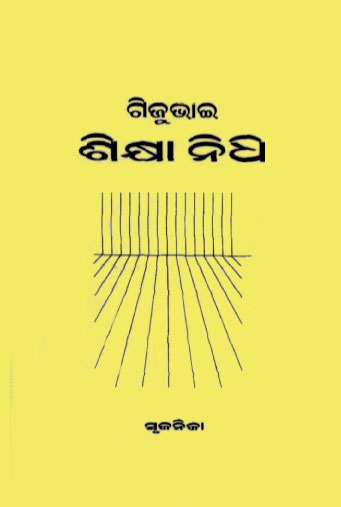Writing for Educators
To My Fellow Teachers,
I am one of you. I present to you thoughts and ideas about our profession, ourselves and our progress, that have occurred to me from time to time. You must put these into practice. I am confident that if we teachers can do this consistently for ten years, if we devote ourselves to education, we can succeed in ushering a new age in our country.
We are among the downtrodden of this country. The uplift of the downtrodden has begun. We must proceed with the same enthusiasm and joy with which the downtrodden of the world have commenced their march. After all, what have we to lose? And there is everything to be gained.
If we march ahead with confidence in ourselves and faith in God, victory will be ours.
Gijubhai, 19/11/1938. Preface to Prathmik Shalama Shikshak
Gijubhai & Montessori
Discovering Montessori
The year was 1911. A young man set up practice as a District Pleader in Vadhwan Camp, in the erstwhile princely state of Bhavnagar in Saurashtra. His practice was doing well, he was gaining a name and earning too, but his heart was not in the machinations of legal matters.
In 1913, he became a father to a son. The advent of the child Narendra triggered the life mission which would launch him into a new role. The man was Gijubhai Badheka and his mission was to bring about a revolution in the field of child development and education.
Indian education during that time was a curious mixture of the Macaulayism as practised by the English rulers and the traditional “spare the rod and spoil the child” tenet. Narendra’s parents saw the sorry state of the local schools and were apprehensive about the kind of education their son would get. Gijubhai yearned for something different for his child, but was not able to visualise what this could be. So he started reading whatever he could find about education and educators. He also started sharing his anxiety and dilemmas with his friends.
One of these was friends was Darbarshri Gopaldas Desai, who visited Vadhwan Camp often. He told Gijubhai “If you want to read literature about children’s education, and see a new kind of school, go to Vaso and meet Motibhai Amin”. This was when the door opened for him. Gijubhai went to Vaso, met Motibhai and saw his school. He came back with many books; among which was a book describing the Montessori Method of education. This was Gijubhai’s introduction to the thinking of Maria Montessori, and her writing.
The more he read, the more deeply he started thinking about children and child development, and about putting the theory to practice. He also started experimenting with young Narendra, and sharing his observations with his friends, as also the ideas of Montessori. As his desire to spend more time and energy into this new challenge grew, the further he drifted from his legal practice.
That is where serendipity stepped in. In 1915, Gijubhai helped to frame the constitution of an educational institution in Bhavnagar called Dakshinamurti. Its founders were kindred spirits, all grappling with dilemmas about education, as well as reading the works of Montessori. This was the turning point. At the age of 32, Gijubhai quit his legal practice, and joined Dakshinamurti in 1916, initially as Assistant Warden of the student’s hostel, and teaching in the High School. His direct interactions with students reinforced his conviction that if real change had to happen – it was critical to start from early childhood. He put forth a proposal to the Board to start an experimental pre-school (Balmandir). His wish was granted and in 1920 the Daxinamurti Balmandir started. This became Gijubhai’s karmabhoomi (the land where one works).
And this is where he applied the Montessori philosophy and method, drawing upon the core beliefs and tenets about child development, while adapting the methods and techniques to suit the local realities.
It is necessary for the teacher to guide the child without letting him feel the pressure too much, so that she may be always ready to supply the desired help but may never be the obstacle between the child and his experience.
If we could say: "We are respectful and courteous in our dealings with children, we treat them as we would like to be treated ourselves" we should certainly have mastered a great educational principle and undoubtedly be setting an example for good education.
Dr. Montessori's Own Handbook 1914
A teacher's work is like flowing water. If we do not understand those who have to be educated; do not think about what they like and what they do not, then our work and theirs will go in vain. The fulfilment of the work of education is not in teaching one or two subjects nor preparing for a certain class, or passing matric or BA. Real education lies in making humans aware about their own unending strengths. It is to reveal the secret of how to animate these and how to use them. To do this requires that the strengths are respected. Their individual development needs to be given first place. Rather than being taught, they need to be guided onto the path of self-knowledge. This is the work of education today.
Gijubhai Badheka 'Note to Teachers' circa 1920
In 1925 Gijubhai took on three major initiatives that created a revolution in the thinking and practice of children’s education across Gujarat. He set up a formal Adhyapan Mandir to train young people in the philosophy and practice of pre-school education based largely on the Montessori philosophy and method. To spread the thinking and to attract larger interest in children’s education, the first Montessori Sammelan (Conference) was held at Daxshinamurti. It was chaired by Saraladevi Sarabhai, who had personal experience in using the Montessori system in educating her own children, and who had tremendous belief in this philosophy. The Sammelan concluded with the setting up of the Nutan Bal Shikshan Sangh, headed by Saraladevi Sarabhai to take the work ahead.
Gijubhai invited all citizens interested in the new children’s education approach to join. The enthusiastic support of these members helped spread the new wave not only across Gujarat, but also other parts of the country. The Sangh became a platform to carry this forward. It was proposed to publish a monthly Shikshan Patrika to give voice to the movement.
In 1928, the second Montessori Sammelan was held at Ahmedabad, presided by Gijubhai. Educationists came from all parts of India and carried back the Montessori message.
Translating Montessori
The work of translating Montessori's educational principles into Gujarati was not easy. To retain the essence and spirit of the philosophy while communicating these in a non-European language, and presenting these in simple Gujarati that an average teacher could understand, was a challenge. Gijubhai lived up to the challenge, dexterously combining his command over language with his depth of knowledge and piercing insights. Montessori Paddhati
The simple but beautifully worded sentences in his book Balshikshan Mane Samjayun Tem (Children’s Education as I Have Understood It) are an invitation and inspiration for the ordinary person to adopt a new perspective. His other books of guidelines on how to teach different subjects in Primary school deftly weave the basic Montessori principles into the real life conditions of primary schools in India, and include familiar examples and easily adoptable classroom practises. Thus Gijubhai did not merely translate Montessori, he successfully ‘trans-adapted’ the philosophy and method for locale-specific contexts. Bal Shikshan: Jaise mein Samajh Paya.
Adapting Montessori
In the period when India was embarking on a Swadeshi movement to counter the British rule in India, there was some criticism and apprehensions in response to Gijubhai’s introduction of the Montessori method. “It is a foreign system,” “it calls for importing of equipment from abroad,” “it promotes western culture,” “It isn’t suited to Indian culture”, etc.
Gijubhai staunchly stood up to theme and countered these misconceptions. He also shared his vision of how the Montessori Method could be adapted for India.
When adopting Montessori for India, we need to imbue it with the Indian spirit. We will experiment with Montessori schools on Indian soil, under the Indian roof. Instead of chairs and tables, our children will sit on asans (mats) and draw on bajots (low tables). Indian children will have their snacks, not seated at a table and with their shoes on. In Montessori classrooms we will create an artistic environment, but the flower arrangements will be in clay pots using the local and seasonal flowers and leaves.
Our children will play music with simple local instruments like ektara and manjira. Instead of plasticine they will make toys with potter’s clay. In the school courtyards children will wander amidst plants of mustard and fenugreek, tulsi and seasonal flowers and even wild thorny shrubs. And yet in these “desi” schools, there will certainly be towels to wipe hands and foot mats to wipe feet; children must wash their hands before they eat, and there will be designated and clean toilet spaces.
We need to set up a Montessori laboratory, one that suits our situation. We should observe our children with a scientific perspective, and undertake experiments based on our learnings. We also have an environment of liberty (swatantry) and spontaneity (the foundation of the experimental soil). The scientific approach requires honesty, detachment, lack of bias, as well as being free from society, tradition and religious straitjackets. Yet this laboratory will need all the equipment requires for measuring as well as supporting child development.
This laboratory will not be able to accept any distinctions based on religion, caste or country. Where are the children of India mentally and physically at this moment in time, and what should be the next step ahead, these will be the discoveries that the laboratory will make for India. Just as Spain has done for itself' Switzerland has done for itself and Ireland has done for itself.
Gijubhai
The question of whether education should be nationalistic or classical was a hotly debated topic at the time. Gijubhai averred that ‘non-classical education could never be nationalist education, and it would not be appropriate to forget the country and the current situation in the name of classical education.
Another false impression being created was that Montessori education was only for rich urban children, and was unsuitable for the lakhs of children in the villages of India. Gijubhai responded to this not by words but by actions. A Balshala (children’s school was set up in the fields opposite the Dakshinamurti Balmandir, for children of the farmers and labourers. Another Balmandir had been set up in the Harijanvas (area where the Harijans lived. This was run by Taraben Modak. In a letter written to Rambhai Pathak, Gijubhai wrote “You will be happy to know that we have recently started a small centre to work with the agricultural labourers. Taraben is improving it day by day. We need people like you who will Take Montessori to the poor. Are you ready?”
Montessori equipment
As new balmandirs began to be set up, there was increasing need for suitable Montessori equipment for these. It was too expensive to order equipment from abroad, and also it took too much time for it to reach. Gijubhai discussed the possibility of developing and producing the equipment locally with a fellow thinker and experimenter Chamanbhai Vaishnav. It was then planned that the equipment would be made in Vadhwan under the supervision of Chamabhai. This was a big step for that time—to make appropriate equipment which was faithful to the Montessori method and design, and which was produced indigenously and at relatively low cost, so as to be widely available to balmandirs. Even in this undertaking, Gijubhai showed that he was a warrior who would leave no stone unturned in his crusade for a new educational system.
Sadly the two great like-minded people never met in person. Madam Montessori first came to India in 1939, the year that Gijubhai passed away, at the invitation of Theosophical Society of India. She was then 69 years old. She made Adayar, Chennai her home and lived there along with her son, Mario till 1946.
By then seeds that her writing had sown had already taken root and spread, and Gijubhai was the gardener that nurtured the early shoots and encouraged the branches to spread far and wide.
The Dakshinamurti Balmandir continues to function today, in its original building, one hundred years after it was first established.
Some thoughts on teaching and learning
This Will Not Do… In Our School
- It will do if our school does not have a vast library of books on education. It will not do if no one reads a single book on education related topics.
- It will do if our school building isn’t clad with fancy stones or tiles. It will not do if there are potholes in the ground, or if its walls are not clad with mud and dung.
- It will do if the walls are not covered with paint. It will not do if there is dust and cobwebs in corners.
- It will do if the floors are not covered by carpets. It will not do if there is litter and dirt strewed on them.
- It will do if there is not a laboratory full of fancy equipment. It will not do if the few equipments that are available are not ever used.
- It will do if there is not a great big library. It will not do if there are not at least a few books that children would enjoy reading.
- It will do if we are not great scholars. It will not do if we cannot give our children due respect, and an environment that encourages their development.
- It will do if we are not constantly engaged in ‘teaching’ children. It will not do if we interfere in their activities, or threaten or force them to sit down to study.
- It will do if the children in our school, study a while and play a while. It will not do if they toil through the day like labourers, under our strict supervision.
- It will do if the children of our school do not cling to us like friends. It will not do if they run at the sight of us, or are afraid of us.
- It will do if our children sit, read or draw because they feel like doing so. It will not do if they paint a picture or sing a song to impress an outsider.
- It will do if our children learn a little less, or a little slower. It will not do if they are screamed at to study, so that they get fed up and become lethargic.
- It will do if children tell us that they did not understand something, or do it slowly, at a later stage. It will not do if they rush through it under duress of punishment.
Gijubhai 1932
Let's Show Them
We can describe the beauty of birds to a child, or we can show them some birds.
We can draw the diagram of an engine on the blackboard, or we can take the child to an engine to see for itself. We can tell tales about the wealth of minerals hidden in the depths of the earth, or we could dig some soil together and explore the depths.
We can lie on the bed and talk about the stars, or we can go up to the terrace and look at them. We can explain to the child that it must not be afraid, that there is nothing to be afraid of, or we can go for a walk in the dark with the child. Or take them to places that they fear and show them how not to be afraid.
We can inspire the child to be brave, and to do great deeds when it grows up, or we can encourage it to do small acts of courage.
We can talk to the child about the millions of poor people in our country, or we can show it the huts of the poor.
We can talk to the child about masters and servants, factory owners and workers, or we can take it to see and meet all these people.
Will this not help the child to develop better?
Gijubhai 1934
Confessions of a Teacher
I am a teacher. I saw an article entitled ‘Teacher’s Confessions’ and thought, why not pen down my own confessions?
I have been in teaching for years now. As a requirement to becoming a teacher, I had at that time, to study the science and principles of education. I have not learnt much more, since then.
I go to public libraries but rarely touch teaching-related journals. A glance at the librarian’s issue book will show several books against my name, but none related to education.
I am certainly in the habit of reading. In the early years I was busy studying the textbooks and related material. But the text books don’t change often. I now need only to glance at the books. My reading list now includes dailies and monthlies and some assorted fiction.
After school hours I rarely discuss education-related topics. My discussion includes topics such as someone’s dismissal or promotion, forms and examinations, higher authorities or fellow teachers, booksellers, and so on.
During recess time, my colleagues gather for a cup of tea. We talk of many things. But never do we talk about how to teach, teaching aids, or students.
The school timings are fixed. The curriculum is set. The school bell heralds the passage of time, and students are prepared for the examinations. The systems are in place. I go to school. Teach the lessons for the day. I carry out my tasks and keep the order – partly by force, partly by wit, partly through my image, and largely through the set disciplinary systems of the school.
I don’t get into the depths of any subject. There is no time; just enough to complete what will be part of the exams. Students will take longer, and explanations will have to be made to the authorities.
I know the students by name, or names of those that know their lessons, and those that do not. I do not know anything about their family, their friends, their own personalities. We are not close. I know their minds, but not their hearts.
I see who comes first, and who is last. I do not know about their physical strengths and weaknesses. Those who finish their work and bring it to me, are clever; those I like. The rest are duds; I do not like them. Between us there is no affection. How can there be trust? They are afraid of me; and I exert my authority over them.
Once I leave the school, I scarcely think of them, save perhaps, one who might have been greatly disrespectful. Each to our own homes. Perhaps, as I lie down the thought may cross my mind that as the exams near, I will have to speed up the revision, for which I’d use the recess.
I haven’t seen the homes of the children. Nor have I shown them my home. I do not have such a relationship with them.
I dream that I will be promoted till some day I become headmaster. I will complete by term of service, retire and enjoy my pension. I hope to save a little before I am too old. That is why I have to take tuitions.
I desire that I am well thought of in my community, that I can educate my children so that they get good jobs, and I can marry them off before I enjoy old age.
It is for this that I wish to work. Today the profession of teaching is, for me, an activity, a job. In all this, the ideals of education, the changing principles and practices of teaching, the desire to bring new changes in the field—all this is not in one, where will they come from?
I would like to explain clearly what my position is today. My state is like this; I presume my fellow teachers are in a similar situation.
Gijubhai 1932
Maria Montessori on Gijubhai
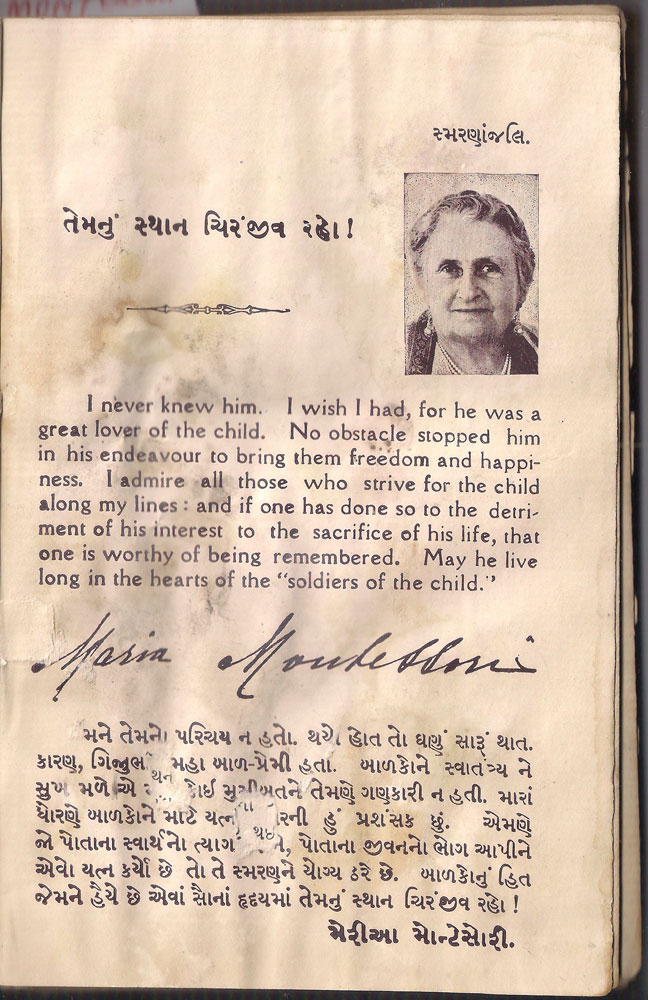
I never knew him. I wish I had, for he was a great lover of the child. No obstacle stopped him in his endeavour to bring them freedom and happiness. I admire all those who strive for the child along my lines: and if one has done so to the detriment of his interest to the sacrifice of his life, that one is worthy of being remembered. May he live long in the hearts of the 'soldiers of the child'.
Based on the original Gujarati sources:
Gijubhai nu Kelavni ma Pradan - Bharatlal Pathak, RR Shethni Company 2003. First published 1978.
Bal Shikishan Praneta: Gijubhai - Ramnarayan Pathak, Sanskar Sahitya Mandir Bhavnagar 1984. First published 1957.
Written by Mamata Pandya
Books for Educators
મોન્તેસ્સોરી પદ્ધતિ
(Montessori Paddhati)
Montessori Method
Author: Gijubhai Badheka
Language: Gujarati
Format: PDF
પ્રાથમિક શાળામાં શિક્ષક
(Prathmik Shalama Shikshak)
The Teacher in Primary School
Author: Gijubhai Badheka
Language: Gujarati
Format: PDF
શબ્દ પોથી
પાઠપોથી ગ્રંથમાળા ૧
(Shabapothi - Pathpothi Granthmala 1)
Teaching language - Words
Author: Gijubhai Badheka
Language: Gujarati
Format: PDF
વાક્ય પોથી
પાઠપોથી ગ્રંથમાળા ૨
(Vakya Pothi - Pathpothi Granthmala 2)
Teaching language - Sentences
Author: Gijubhai Badheka
Language: Gujarati
Format: PDF
વ્યાકરણ પોથી
પાઠપોથી ગ્રંથમાળા ૩
(Vyakaran Pothi Pathpothi Granthmala 3)
Teaching language - Grammar
Author: Gijubhai Badheka
Language: Gujarati
Format: PDF
મોટા પાઠો
પાઠપોથી ગ્રંથમાળા ૪
(Mota Paatho - Pathpothi Granthmala 4)
Teaching language - Bigger lessons
Author: Gijubhai Badheka
Language: Gujarati
Format: PDF
ચિઠી પોથી
પાઠપોથી ગ્રંથમાળા ५
(Chitthi Pothi - Pathpothi Granthmala 5)
Teaching language - Read and Do Chits
Author: Gijubhai Badheka
Language: Gujarati
Format: PDF
बालशिक्षण जैसे मैं समझ पाया
(Bal shikshan Jaise Main Samajh Paya)
Child education as I understand it
Author: Gijubhai Badheka
Language: Hindi
Format: PDF
मोंटेसरी पद्धति
भाग - १
(Montessori Paddhati Part 1)
Montessori Method
Author: Gijubhai Badheka
Language: Hindi
Format: PDF
मोंटेसरी पद्धति
भाग - २
(Montessori Paddhati Part 2)
Montessori Method
Author: Gijubhai Badheka
Language: Hindi
Format: PDF
प्राथमिक शाला में भाषा शिक्षण
(Parthmik Shalamein Bhasha Shikshan)
Language teaching in primary school
Author: Gijubhai Badheka
Language: Hindi
Format: PDF
प्राथमिक शाला में चिट्ठी वाचन
(Prathmik Shalamein Chitthi Vachan)
Using Read and Do chits in primary school
Author: Gijubhai Badheka
Language: Hindi
Format: PDF
प्राथमिक शाला में शिक्षा पद्धतियां
(Prathmik Shalamein Shiksha Paddhatiyan)
Teaching methods in primary school
Author: Gijubhai Badheka
Language: Hindi
Format: PDF
प्राथमिक शाला में शिक्षक
(Prathmik Shalamein Shikshak)
The teacher in primary school
Author: Gijubhai Badheka
Language: Hindi
Format: PDF
शिक्षक हों तो
(Shikshak Hon To)
If You Are a Teacher
Author: Gijubhai Badheka
Language: Hindi
Format: PDF
प्राथमिक शाला में कला-कारीगिरी की शिक्षा - भाग 1
(Prathmik Shalamein Kala-karigiri ki Shiksha Part 1)
Teaching art and craft in primary school
Author: Gijubhai Badheka
Language: Hindi
Format: PDF
प्राथमिक शाला में कला-कारीगिरी की शिक्षा - भाग 2
(Prathmik Shalamein Kala-karigiri ki Shiksha Part 2)
Teaching art and craft in primary school
Author: Gijubhai Badheka
Language: Hindi
Format: PDF
Gijubhai Shiksanidhi
Gijubhai Shikshanidhi Odia - On education
Author: Gijubhai Badheka
Language: Odia
Format: PDF
